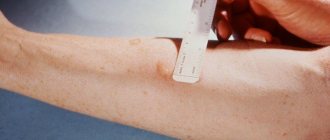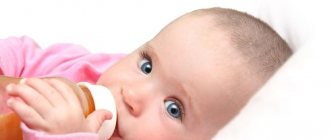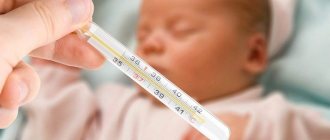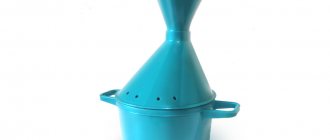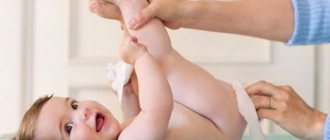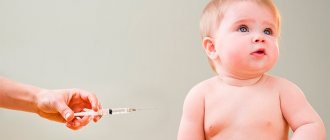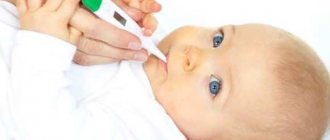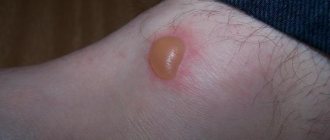Roseola in children (pseudo-rubella, three-day fever or sudden exanthema) is an infectious disease that mainly affects preschool children. The causative agent of the disease is herpes virus types 6 and 7.
Since almost every person on earth is a carrier of this type of infection, usually in adults the disease passes easily and unnoticed, since antibodies to the virus already exist in the blood. If there is a suspicion of the disease in adults, photos with explanations will help to understand the cause of the rash, but it is better to seek specialized help.
Symptoms of roseola in children are more pronounced; a rash almost always occurs.
The advantage of suffering from an illness is that antibodies remain in the blood, protecting the body throughout life.
If skin reactions occur in a child, parents should know what roseola and other diseases look like in order to be able to distinguish them and properly help the child. Many diseases have similar symptoms, but the treatment is completely different. Of course, parents immediately have many questions: how to treat it, is it possible to walk with roseola and wash the child?
Rash differentiation
There are many diseases of various origins, skin reactions in which manifest themselves on the baby’s body in a similar way.
With so many of them, the mother herself cannot distinguish a rash with roseola from rashes of a different nature.
You need to know the following about roseola rashes:
- The body temperature level is elevated for 2-4 days, after which skin reactions appear;
- First of all, small papules appear on the torso, quickly spreading to other parts of the body: face, arms and legs;
- Roseolas are characterized by a diameter of 1-6 mm, red color, due to the expansion of capillaries, around which there may be a pale corolla. They protrude slightly above the skin level;
- The elements of the rash do not merge with each other, have an irregular shape and an uneven contour;
- The rash does not cause itching or peeling of the skin;
- It does not leave complications in the form of pigmentation or scars;
- When you press on the spot, it turns pale, which is not typical for other skin infections;
- the disease is not characterized by other skin changes;
- The rash does not need to be lubricated with anything, as it does not cause discomfort.
The infectious disease roseola needs to be differentiated from others, so you need to know these features. This photo shows typical rashes on a baby's skin with pseudorubella.
Your help for a child with roseola
Most childhood diseases are characterized by only three symptoms - an acute onset, an increase in body temperature to high levels, and the appearance of a rash. Infantile roseola is no exception - it also begins with the appearance of fever. However, compared to other diseases, there is one important clinical symptom - the duration of the temperature before the appearance of the rash. This is the only specific manifestation due to which both parents and pediatricians may suspect sudden roseola.
Most often, the disease develops after the first six months - up to two years of life. Almost all children in the fourth year already have positive antibodies to certain types of herpeviruses.
Most often, baby roseola appears in the spring and the first month of summer. This must be taken into account by parents if there is a sudden increase in body temperature in babies, which is not accompanied by the appearance of other symptoms.
What do you know about Roseola? What it is? And how dangerous is it for your child?
Sudden exanthema begins acutely - against the background of complete well-being, the body temperature of children suddenly begins to rise and reaches 38.5-40°C. The baby becomes restless - overly excited or, conversely, lethargic and apathetic. Children, after one and a half years, may say that they have a headache, muscle pain and sleepiness - these are typical symptoms of intoxication with an increase in body temperature.
The incubation period for baby roseola ranges from 5 to 15 days. This is the period during which the virus enters the body and actively multiplies until the first sign of illness appears - a high body temperature of 39-40°C.
Fever in children persists for three days, sometimes four. During this period, no other symptoms appear. After which, the temperature drops and after a few hours a rash similar to childhood rubella appears.
Roseola infantile rash
12
Sudden exanthema is characterized by the appearance of a rubella-like rash. The first elements of the rash may appear on the chest, back or abdomen. Within a few hours they spread to all parts of the body. Sometimes the rash affects the elbows and knees, and then spreads to the torso. On the face, a rash with roseola is quite rare, which can be used for differential diagnosis with rubella.
Dr. Komarovsky - how not to confuse Roseola with Rubella?
In most cases, sudden exanthema does not require specific treatment. Symptomatic therapy is carried out, the purpose of which is to stabilize the child’s condition and reduce hyperthermia (increased body temperature).
Children of the first year of life, when their body temperature rises to 39°C, must be hospitalized in a hospital.
The only specific therapy with proven effectiveness is Ganciclovir. It is administered exclusively in a hospital setting! In case of sudden exanthema in children, the drug removes viral particles from the child’s body and reduces the activity of virus reproduction.
Drugs such as Acyclovir are ineffective in the development of roseola infantum. For symptomatic therapy to reduce temperature, Panadol Baby is used.
After the temperature drops, elements of the rash appear. They do not require additional treatment with antiseptic drugs.
Ganciclovir and Panadol Baby
12
In rare cases, when a secondary bacterial infection occurs, antibiotics may be prescribed. The choice of a specific drug depends on the system of damage and the sensitivity of the pathogen.
ethnoscience
Traditional medicine methods are not used to treat infantile roseola. The use of decoctions, alcohol tinctures and ordinary infusions can provoke the development of allergic reactions and reduce the immune defense of the child’s body.
Applying compresses and wiping the baby with decoctions during the period of roseola appearance can lead to the addition of a secondary bacterial infection.
The only recommendation that will not harm the baby, but rather will contribute to his recovery, is to drink more fluids. However, it can rather be attributed to non-drug methods of therapy rather than traditional treatment.
The first signs of pathology in children appear 1-2 weeks after infection.
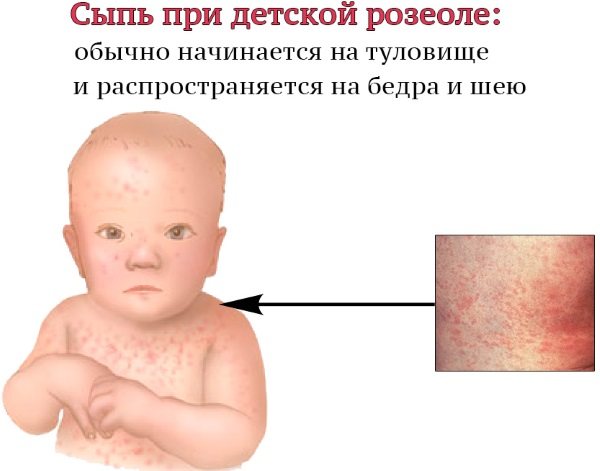
A rash is one of the main symptoms of roseola in children.
Roseola is characterized by the following symptoms:
- The temperature rises sharply (up to 38°C and above). After 3-5 days it subsides.
- Skin rashes appear after fever. We are talking about multiple spots or plaques. Sometimes they are flat and have a pink tint. The rash affects the stomach, back, chest, then spreads to the upper and lower limbs, face, and neck. Symptomatic treatment is required in some cases, but more often the rash goes away on its own.
- The lymph nodes in the neck enlarge (swell).
- Pain syndrome occurs in the throat area.
- A mild form of roseola in children is accompanied by a runny nose and cough.
- The child becomes whiny.
- Appetite decreases and weight decreases.
- Limbs go numb.
- Eyelids swell.
In rare cases, a mild form of pathology is accompanied by stool disorder (diarrhea), nausea, and disturbances in the digestive system. Timely diagnosis of the disease and properly selected treatment will prevent serious complications.
In most cases, the disease goes away on its own within a week, but for a complete recovery, parents must remember the doctors’ recommendations and properly care for the child. It is important that the baby rests more and drinks plenty of fluids.
Drug treatment is prescribed by a pediatrician after a thorough examination and based on diagnostic results. Self-medication in the case of children is unacceptable, since there is a high risk of causing complications.
Roseola in children (symptoms of a viral disease are eliminated with medications) in most cases goes away on its own. Drug treatment requires consultation with a pediatrician. It is important to adhere to prescriptions and give your child medications strictly according to instructions to prevent side effects.
| Group of drugs | Name | Application | Efficiency |
| Antipyretics. | "Paracetamol", "Nurofen", "Panadol". | 10-15 mg per 1 kg, 4 rubles. per day. The time interval between doses is 4-6 hours. | Medicines reduce fever, eliminate pain and inflammation. |
| Antiviral. | "Acyclovir", "Zovirax". | 20 mg/kg 4 times. per day for 5 days. | Kill viral pathogenic microorganisms. |
| Antihistamines. | "Suprastin, "Tavegil". | The maximum daily dosage is 2 mg/kg. Children 1-12 months: 0.25 ml, 1-6 l. 0.5 ml, 6-14 l. 0.5-1 ml. The medicine can be given in tablets. | The medicine has antiallergic and antihistamine effects. Reduces the appearance of rashes and spots on the child's skin. |
In addition to traditional treatment, it is important to follow the regimen and recommendations of the pediatrician:
- give your baby more fluids;
- adhere to bed rest, especially if there is a high body temperature;
- ventilate the room, maintain optimal air humidity.
Glucose helps eliminate symptoms of intoxication. To stimulate the immune system, immunoglobulins are prescribed. Medicines are administered intravenously or intramuscularly. Additionally, children are prescribed vitamin complexes to support the immune system.
Traditional methods
Recipes from witch doctors and healers help eliminate skin rashes and help quickly restore the functioning of a child’s body. Treatment is applied after consultation with a pediatrician.
We invite you to familiarize yourself with Perioral dermatitis: photos, treatment, causes and symptoms
| Name | Recipe | Application and effectiveness |
| Aloe juice. | Fresh leaves of the plant are crushed into pulp and filtered through cheesecloth. | The juice is taken orally, 1 tsp. 3 r. per day. The gruel is used for compresses. |
| Yarrow. | Dry grass (200 g) is crushed and poured with hot water (3 l). Leave for 40 minutes. | The solution is filtered and poured into a previously prepared bath. Water procedures are recommended to be carried out 30 minutes before bedtime. |
| Chamomile tea. | Pour boiling water (150 ml) over the dried flowers of the plant (1 tsp). Leave for 5 minutes. Strain and give to your child as tea. If necessary, you can add honey or a small amount of sugar. | Helps restore the functioning of the immune system, reduce inflammation and fever. Chamomile copes well with infections and eliminates skin rashes. |
Raw potato juice can reduce skin rashes. Peel the product, wash and grate. The resulting juice is applied to the affected areas 3 times a day. Pediatricians recommend bathing your baby with celandine added to the water. It soothes baby's delicate skin and reduces rashes.
Other methods
The main methods of combating roseola are aimed at reducing fever and eliminating symptoms of intoxication.
It is important to provide the patient with the most comfortable conditions:
- eliminate noise sources;
- undress the child so as not to disturb the transfer of heat;
- maintain room temperature within 20°C;
- ventilate the room in which the child is located every day;
- do wet cleaning.
If a child has convulsions at a high temperature, it is recommended to lay him on his side. Hold hands and feet to prevent injury. After an attack, give antipyretic medications and call an ambulance.
The disease is caused by the herpes virus type six, less commonly - type seven (hence one of the names - “sixth disease”). There is seasonality: late spring - early summer.
The causative agent of the disease is ubiquitous. You can become infected from a “healthy” virus carrier or a patient in the first three to four days of illness.
Almost all of us experience roseola by the age of three or four years. The most vulnerable age is from six months to one and a half to two years. Newborns and children in the first six months of life rarely get roseola, since the mother passes on protective antibodies through breast milk.
It is believed that the virus enters the child’s body by inhaling contaminated air. After an infection, lifelong immunity is developed, so the disease does not occur a second time.
However, the virus itself does not disappear anywhere, but remains in our body for life, but is in a “dormant” state. It is assumed that when the immune system is weakened, it can “wake up” and cause health problems.
What does it look like
Most of the symptoms of infantile roseola are general, that is, they are characteristic of almost any infection. These are nausea, loss of appetite and weakness.
Rash with roseola is a more typical symptom, but it can also cause difficulties even for an inexperienced doctor; parents themselves are unlikely to be able to make a diagnosis.
Changes in skin pattern, papular elements: rashes, spots, papules have the features described above. If they appear, you need to contact a pediatrician, infectious disease specialist or dermatologist. These doctors will be able to conduct additional studies and tests to accurately diagnose and prescribe the correct treatment.
Diseases with which the disease must first be differentiated, since their main symptom is also a rash:
- measles;
- rubella;
- allergic reaction;
- secondary syphilis;
- scarlet fever;
- medicinal toxicodermy.
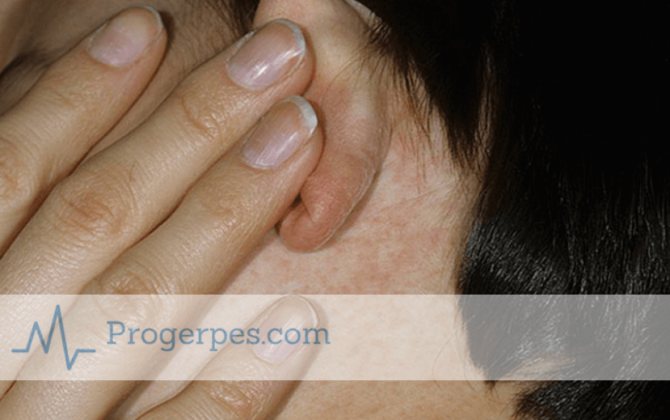
Parents should be alarmed if there is a sharp increase in temperature, since during this period, if the diagnosis is confirmed, febrile convulsions may occur; it is necessary to be able to prevent them. If the child is not sick with pseudorubella, he may require specific treatment. Serious complications are possible if some diseases are missed and therapy is not applied on time. Or, on the contrary, the use of antibiotics, which will not help in the treatment of roseola, because the disease is viral, can cause serious harm to the weak body of the baby.
Diagnostics: tests do not cure
Particles of the virus (DNA) are detected in the blood using the polymerase chain reaction (PCR). Detection of DNA only indicates the presence of the virus in the body. Based only on the results of the study, it is impossible to say for sure whether a child or an adult is sick at the time of the examination.
Additional examinations will help determine the cause of the development of pathological processes and establish an accurate diagnosis. The pediatrician takes into account the patient’s complaints, examines skin rashes (determines the type, shape, number, location of spots, characteristic accompanying manifestations and skin changes).
| Name | Description | Price |
| Polymerase chain reaction. | The cerebrospinal fluid is examined for the detection of enteroviral RNA. | from 300 rub. |
| Serological blood tests. | The results will show increased levels of antibodies that the immune system has produced to fight the disease. | from 500 rub. |
| Cerebrospinal fluid examination. | Diagnostics is prescribed when there is a suspicion of damage by pathogenic microorganisms to the spinal cord or brain, or their membranes. Using a puncture, a small amount of material is taken from the patient's spinal canal. | from 250 rub. |
| Reverse transcriptase polymerase chain reaction. | Allows you to identify common genetic regions of numerous viruses. | from 300 rub. |
| General blood analysis. | The results will show the development of leukopenia and relative lymphocytosis (high level of lymphocytes). The erythrocyte sedimentation rate also increases. | from 300 rub. |
| Ultrasound examination (ultrasound) of the abdominal organs. | If there are symptoms indicating an enlarged spleen and liver. | from 650 rub. |
If necessary, to obtain the most useful information, children with roseola are additionally prescribed echocardiography, electroencephalography, chest x-ray and ophthalmological examination.
The diagnosis of roseola is made on the basis of the clinical picture, as well as laboratory data. It is extremely important to collect medical history data - information about who the baby has been in contact with and what illnesses his family members, as well as immediate relatives, have.
To confirm sudden exanthema in children, it is necessary to take blood tests for serological diagnosis and polymerase chain reaction.
In case of childhood infection, the following changes are observed in the general blood test:
- leukopenia;
- neutropenia;
- relative lymphocytosis with a normal value of the absolute number of lymphocytes;
- an increase in the number of young forms of white blood cells - monocytosis.
The diagnostic criterion for an acute process is an increase in the titer of immunoglobulin G to herpes virus type 6 when conducting a study of paired sera.
In children after three years of age, stable IgG titers to the herpes virus are determined in the blood, which indicate an infection or its presence in the body in a latent (latent) state.
Syphilitic roseola
Syphilis is a serious sexually transmitted disease; a child can become infected from the mother in utero or during childbirth. With secondary syphilis, which is characterized by roseola rashes, they should be preceded by the appearance of a primary chancre.
There are different types of manifestations of the disease:
- spotted syphilides (elevations that resemble blisters);
- papular syphilides (the most common variant);
- lenticular syphilides (small vesicular elements);
- coin-shaped syphilides (large in size, about 1-2.5 cm).
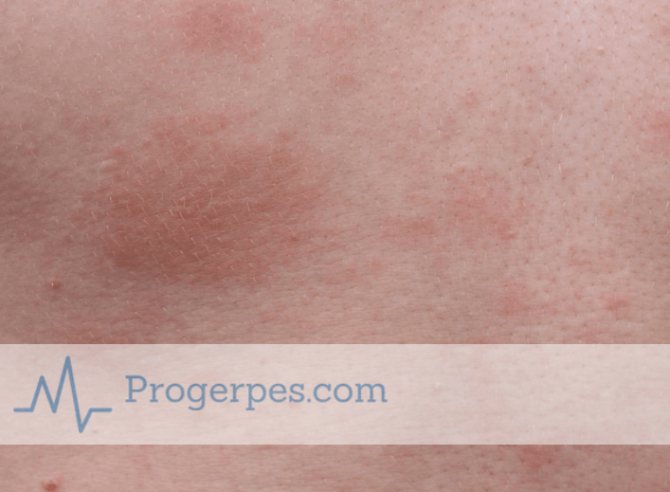
Such papules can leave brown spots behind. Their color depends on the blood supply to this area and the depth of their placement under the skin.
When to see a doctor
Roseola therapy in children is carried out by a pediatrician.
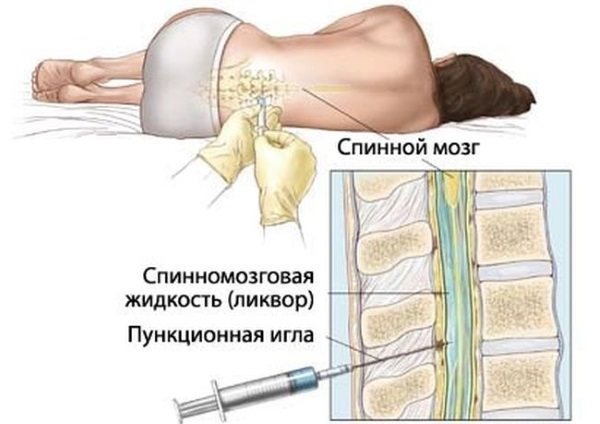
It is important to consult a specialist if the following pathological changes occur:
- a child’s high temperature lasts longer than a day;
- the rash does not go away after 3 days;
- the child is weak and has apathy towards the world around him;
- appetite worsens every day.
Roseola in children (symptoms of the disease do not appear immediately, but several days after infection of the body) requires the help of a pediatrician, especially if the young patient has a weak immune system. High temperature provokes serious complications when the child’s body is not able to resist pathological processes.
A slight rise in temperature that lasts more than 7 days should also alert parents and force them to see a doctor. Sharp and unexpected deterioration, as well as the appearance of febrile convulsions, require emergency medical attention.
Is treatment necessary?
The disease has no specific treatment. In general, it does not last long, about a week. At this time, it is necessary to help the child, reduce his suffering, create conditions for an easier course of the disease and provide care for the baby.
When parents contact a medical facility, the doctor can conduct additional tests to ensure the accuracy of the diagnosis and advise parents about the care and medications that are used during the period of roseola. Depending on how many days the temperature and rash with roseola lasts, one can judge the severity of the process.
Prevention of roseola
It is impossible to prevent such a childhood disease as sudden roseola. It also does not seem realistic to limit a child from contact with other people.
The only method of preventing childhood roseola is to strengthen the baby’s immunity through breastfeeding, consistent physical development and timely vaccination against other childhood infections.
Infantile roseola is an acute infectious disease that affects babies from 6 to 24 months. The disease begins suddenly, with an increase in body temperature to 39-40°C. One of the characteristic symptoms is the appearance of a rash after the temperature drops. The disease does not require specific treatment. Complications are extremely rare.
Children's Roseola - a case from life
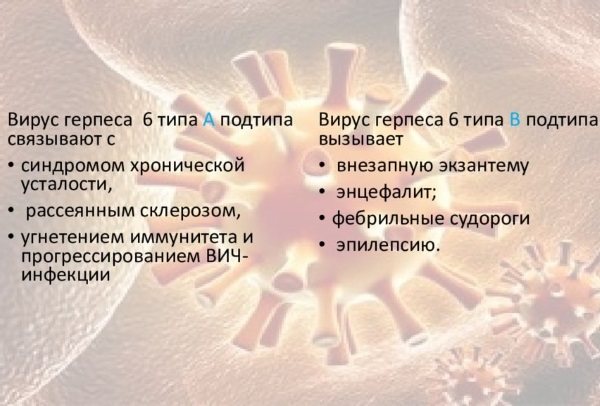
Classic pediatrician recommendations will help prevent the disease:
- nutritious nutrition, which should contain foods with plenty of minerals and vitamins;
- observed daily routine;
- hardening of the child's body;
- Dress appropriately for the weather to prevent overheating or hypothermia.
If a child is sick, it is important to isolate him and carefully monitor his condition to prevent the baby’s condition from worsening. After experiencing roseola, children develop lifelong immunity to this virus. A vaccine against sudden exanthema has not yet been developed.
Doctors' mistakes
The symptoms of sudden exanthema are very vague, dim, and have few specific manifestations. When visiting a doctor, he must conduct the necessary research:
- Examination of the body, external characteristics of the rash, its peculiarity with roseola is paleness after pressing;
- A general blood test, which will indicate a decrease in the number of leukocytes, eosinophils and an increase in lymphocytes;
- Serological reactions - ELISA, which will indicate an increase in antibodies in the blood to the pathogen;
- Polymerase chain reaction (PCR) - provides data about the DNA of the virus to accurately determine its type.
You need to understand that doctors can make mistakes or treat the manifestations of the disease negligently. They may suspect some other cause of the rash, such as an allergy. This is the most common mistake; this is the diagnosis most often made. In such cases, the doctor will prescribe antihistamines, which are not needed to treat pseudorubella. Since, after a few days, roseola goes away on its own, parents do not know about the disease, believing that the prescribed therapy helped in treating the disease.
A serious mistake would be the wrong treatment of rubella. Often, local doctors neglect to conduct tests to calculate the amount of antibodies in the blood. Parents should insist on this themselves before giving their child a prescribed antibiotic. After all, this is a strong medicine that does not make sense in the treatment of a viral disease, can lead to some health complications and cause some microorganisms to become resistant to treatment in the future.
It is not difficult to distinguish these diseases - with rubella, the rash appears at the beginning of the disease, along with a rise in temperature, with roseola - after it, on days 2-4. Depending on age, roseola manifests itself differently. In more mature people, it may go unnoticed at all, or with a slight rise in temperature.
Rash after fever and nothing else - this is roseola infantile - Diagnostician
The child is 11 months old. Temperature 38.3°C for the third day. Nurofen does not help for long. Diarrhea all three days. I've never had an allergy, but yesterday I had it all over my back. The doctor said you have an acute respiratory infection due to teething. When other teeth came in, the temperature did not rise. It doesn’t look like an acute respiratory infection - no runny nose or cough. Lena
I studied this “bastard” on two children :) Only Lena didn’t write it down - when the rash appeared, the fever subsided. This is roseola. Maria
Description of infantile roseola (sudden exanthema): Temperatures above 39°C last for 3-4 days, temperatures below 39°C can last up to 8 days. Fever may be combined with diarrhea, decreased appetite, and headache. There are no other manifestations of the disease - no runny nose or cough. After 3-4 days of persistent fever, a rash appears - first on the face, chest and abdomen, and after a few hours throughout the body. Sometimes the cervical lymph nodes are enlarged, swelling around the eyes and red papules on the soft palate (Nagayama spots). After the rash appears, the temperature no longer rises. The rash goes away in 3-4 days without treatment.
Important. The rash that appears after the temperature normalizes is frightening: “First the temperature, and now the rash!” In fact, this is a sign of the end of the disease.
| Photo Infantile roseola (sudden exanthema): bright spotted and maculopapular rash; herpetic sore throat with ECHO exanthema. |
READ ALSO: What do pimples on the head of the penis mean?
ECHO-exanthema (infectious exanthema) proceeds similarly - the rash appears after the temperature normalizes. With ECHO exanthema, herpetic sore throat and diarrhea are common.
The child is 10 months old. At night the temperature rose to 39.8°C. For three days the temperature did not drop below 38. No runny nose, no cough. On the third day, red spots appeared on the face, head, back and stomach (nothing new was given from food). No temperature. The child doesn't seem to be itching. Kat
If you notice that your temperature has dropped and a rash has appeared, then this may be infantile roseola, and not an allergy to medications. The rash reaches the belly and buttocks, and is often absent on the legs. But this is not a strict rule; it may be on legs. Vita
I'm 32 years old and the exact same thing happened to me. I feel OK. I have no idea where I picked it up. The day before, I drank a little at the bar and ate some rolls and solyanka. Roseola or not roseola, a rash broke out on the third day. I took an allergy pill and there was practically nothing left of the rash. It worked out. Vadim
A very interesting infection with characteristic symptoms. At the beginning the temperature rises and that's it. There is nothing else - no cough, no runny nose. The uncertain state lasts about three days. Then the temperature drops, and the active child runs around the house asking for food. Everyone at home experiences a feeling of deep satisfaction in connection with recovery from an incomprehensible illness. But 10-20 hours after the temperature normalizes, when the child seems absolutely healthy, a small-spotted pink rash suddenly appears all over the body. In three days of an unexplained rise in temperature, parents will have time to “stick” 3-4 medications into their child. Doctors consider the appearance of a mom-dad-baby rash as a sign of a drug allergy. Allergy medications are prescribed. Although the rash usually goes away on its own within 3-7 days. Roseola is a unique disease! It is not dangerous, does not cause complications, and does not require treatment.
Everything matches. We got sick at 6 months - temperature up to 39.5°C, rash after 3 days. The rash went away after 4 days and everything is fine. This is the first acquaintance with the herpes virus. Don't be alarmed. Higher medical education helped not to end up with an infectious disease with roseola :)) Lala
The temperature stood for a long time and was high (without being knocked down by anything), and then dropped sharply. A rash broke out all over my body. I thought it was rubella. The doctor said it was roseola. The result: three days under house arrest and drink more fluids. No antibiotics or other bullshit. Alya
We had the same thing a year ago... After recovery, we tested for viruses. Herpes simplex virus type 6 was found. There were all sorts of infectious disease specialists, and all sorts of regimens they tried. Herpes has no cure. It all comes down to hardening the body. We tried to go to kindergarten 6 times in 2 years - and all attempts ended in the hospital. The immune system is weakened by this infection. And one more thing: after we got over this three-day fever, our temperature is now always 37.1 - 37.6 for the past 2 years. Faith
Sudden exanthema according to ICD10 B08.2. This disease is common in children. Infantile roseola (sudden exanthema) is caused by herpes virus type 6 (HHV-6). Febrile seizures in children under 2 years of age, fever without a focus of infection, and Epstein-Bar negative mononucleosis are often caused by herpes virus infection type 6 (HHV-6). In rare cases, the virus causes fulminant hepatitis and encephalitis, as well as Rosai-Dorfman syndrome (generalized lymphadenopathy).
READ ALSO: Rash on the tongue: types, causes, photos, symptoms, treatment
Unfortunately, awareness of this disease among pediatricians and infectious disease specialists is extremely low.
Take care of yourself, Your Diagnosticer !
News MirTesen

